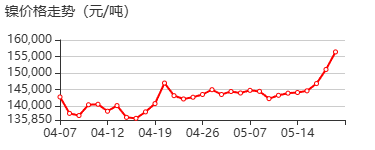镍基合金粉末

镍基合金粉末 性质
| 熔点 | 1453 °C (lit.) |
|---|---|
| 沸点 | 2732 °C (lit.) |
| 密度 | 8.9 g/mL at 25 °C (lit.) |
| 堆积密度 | 1600-2600kg/m3 |
| 蒸气密度 | 5.8 (vs air) |
| 储存条件 | no restrictions. |
| 溶解度 | 不溶于水;微溶于稀酸溶液 |
| 形态 | 金属丝状 |
| 颜色 | 白色至灰白色 |
| 比重 | 8.9 |
| PH值 | 8.5-12.0 |
| 气味 (Odor) | 无味 |
| 酸碱指示剂变色ph值范围 | 9 - 11 at 20 °C |
| Flame Color | Colorless to silvery white |
| 电阻率 (resistivity) | 6.97 μΩ-cm, 20°C |
| 水溶解性 | It is insoluble in water. |
| 敏感性 | air sensitive |
| Merck | 14,8107 |
| 暴露限值 | TLA-TWA (metal) 1 mg/m3 (ACGIH, MSHA, and OSHA); (soluble inorganic compounds) 0.1 mg(Ni)/m3 (ACGIH) 0.015 mg (Ni)/m3 (NIOSH); (insoluble inorganic compounds) 1 mg/m3 (ACGIH). |
| 稳定性 | 块状稳定。粉末可以自燃。可能与钛、硝酸铵、高氯酸钾、叠氮酸剧烈反应。与酸、氧化剂、硫磺不相容。 |
| InChIKey | PXHVJJICTQNCMI-UHFFFAOYSA-N |
| CAS 数据库 | 7440-02-0(CAS DataBase Reference) |
| (IARC)致癌物分类 | 2B (Vol. Sup 7, 49) 1990 |
| NIST化学物质信息 | Nickel(7440-02-0) |
| EPA化学物质信息 | Nickel (7440-02-0) |
镍基合金粉末 用途与合成方法
镍基高温合金球形粉末是指粒度微米级的球形或者近球形镍基高温合金粉末。镍基高温合金是指在650~1 000℃高温下有较高的强度、抗氧化性和耐腐蚀性等高温性能较为良好的一类合金。按照主要性能又细分为镍基耐热合金,镍基耐蚀合金,镍基耐磨合金,镍基精密合金与镍基形状记忆合金等。
镍基合金粉末可用于选区激光熔化(SLM)、电子束熔融(EBM)、激光直接沉积(DLD)、粉末冶金(PM)、注射成型(MIM),激光熔覆(Laser Cladding)等工艺,适用于增材制造及新材料研发试验。In718/GH4169球形镍基粉末,由于在 700℃时具有高温强度和优秀的耐腐蚀性能、易加工性,可广泛应用于各种高要求的场合,如航空发动机零部件及石油化工应用零件。
镍基合金粉末有自熔性合金粉末与非自熔性合金粉末两种类别。
非自熔性镍基粉末是指不含B、Si或B、Si含量较低的镍基合金粉末。这类粉末,广泛的应用于等离子弧喷涂涂层、火焰喷涂涂层和等离子表面强化。主要包括:Ni-Cr合金粉末、Ni-Cr-Mo合金粉末、Ni-Cr-Fe合金粉末、Ni-Cu合金粉末、Ni-P和Ni-Cr-P合金粉末、Ni-Cr-Mo-Fe合金粉末、Ni-Cr-Mo-Si高耐磨合金粉末、Ni-Cr-Fe-Al合金粉末、Ni-Cr-Fe-Al-B-Si合金粉末、Ni-Cr-Si合金粉末、Ni-Cr-W基耐磨耐蚀合金粉末等。
在镍合金粉末中加入适量B、Si便形成了镍基自熔性合金粉末。所谓自熔性合金粉末亦称低共熔合金,硬面合金,是在镍、钴、铁基合金中加入能形低熔点共晶体的合金元素(主要是硼和硅)而形成的一系列粉末材料。常用的镍基自熔性合金粉末有Ni-B-Si合金粉末、Ni-Cr-B-Si合金粉末、Ni-Cr-B-Si-Mo、Ni-Cr-B-Si-Mo-Cu、高钼镍基自熔性合金粉末、高铬钼镍基自熔性合金粉末、Ni-Cr-W-C基自熔性合金粉末、高铜自熔性合金粉末、碳化钨弥散型镍基自熔性合金粉末等。
安全信息
| 危险品标志 | C,Xi,Xn,F,T |
|---|---|
| 危险类别码 | 34-50/53-43-40-10-17-52/53-48/23 |
| 安全说明 | 26-45-60-61-36-22-36/37-16-15-5-36/37/39-43-28 |
| 危险品运输编号 | UN 1493 5.1/PG 2 |
| 职业暴露等级 | D |
| 职业暴露限值 | TWA: 0.015 mg/m3 [*Note: The REL does not apply to Nickel carbonyl.] |
| WGK Germany | 3 |
| RTECS号 | VW4725000 |
| F | 8 |
| 自燃温度 | 87 °C |
| TSCA | Yes |
| 危险等级 | 4.1 |
| 包装类别 | II |
| 海关编码 | 38151100 |
| 毒害物质数据 | 7440-02-0(Hazardous Substances Data) |
| 毒性 | Occupational exposures may occur in its mining, smelting, and refining. The general population ingests nickel in food. Skin sensitization and dermatitis leading to chronic eczema, called “nickel itch,” frequently occurs, especially in wearers of pierced earrings. Nickel can also irritate the conjunctiva and respiratory tract mucous membranes. Absorption from the digestive tract is poor, so systemic poisoning is rare, but since it is an irritant it acts as an emetic. Systemic effects include hyperglycemia, capillary damage, CNS depression, myocardial weakness, and kidney damage. Nickel and its compounds are carcinogenic following inhalation, but not following ingestion or skin contact. Cancer of the lung and nasal passages results, with a latent period of about 25 years; smokers are at greater risk. In addition to irritation and carcinogenesis, nickel carbonyl (nickel tetracarbonyl, Ni(CO)4) exerts relatively mild, tran_x0002_sientinitial symptoms including headache, giddiness, nausea, and shortness of breath. These symptoms are followed by very serious symptoms hours to days later, consisting of tightness in the chest, shortness of breath, rapid respiration, pulmonary edema, cyanosis, and extreme weakness; this can be fatal. Heat decomposition of nickel carbonyl yields carbon monoxide. Chelating agents can be used to remove nickel from the body. |
| 立即威胁生命和健康浓度 | 10 mg Ni/m3 |
MSDS信息
镍基合金粉末 价格(试剂级)
| 更新日期 | 产品编号 | 产品名称 | CAS号 | 包装 | 价格 |
|---|---|---|---|---|---|
| 2025-02-08 | 51016481 | 镍丝 0.5MM | 7440-02-0 | 袋 | 609 |
| 2025-02-08 | 51016360 | 镍丝1MM | 7440-02-0 | 100G | 134 |


